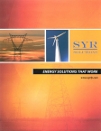



| Home | Electricity | Environment | Market Update | Contact Us |
The sun, with all those planets revolving around it and dependent on it, can still ripen a bunch of grapes as if it had nothing else in the universe to do.
Galileo Galilei
| Environment |
| Renewable Energy |
| GHG Emissions |
Greenhouse Gas (GHG) Emissions
Many chemical compounds found in the Earth’s atmosphere act as "greenhouse gases." These gases allow sunlight to enter the atmosphere freely. When sunlight strikes the Earth’s surface, some of it is re-radiated back towards space as infrared radiation (heat). Greenhouse gases absorb this infrared radiation and trap the heat in the atmosphere. Many gases exhibit these "greenhouse" properties. Some of them occur in nature (water vapor, carbon dioxide, methane, and nitrous oxide), while others are exclusively human made (certain industrial gases). Over time, if atmospheric concentrations of greenhouse gases remain relatively stable, the amount of energy sent from the sun to the Earth’s surface should be about the same as the amount of energy radiated back into space, leaving the temperature of the Earth’s surface roughly constant.In the United States, greenhouse gas emissions come primarily from the combustion of fossil fuels in energy use. Fossil fuels are made up of hydrogen and carbon. When fossil fuels are burned, the carbon combines with oxygen to yield carbon dioxide. The amount of carbon dioxide produced depends on the carbon content of the fuel; for example, for each unit of energy produced, natural gas emits about half and petroleum fuels about three-quarters of the carbon dioxide produced by coal.
Fossil fuels supply 85 percent of the primary energy consumed in the United States and are responsible for 98 percent of emissions of carbon dioxide. Eighty percent of U.S. carbon dioxide emissions come from the use of coal and petroleum fuels. Although the industrial sector is the largest energy consumer (including direct fuel use and purchased electricity), the transportation sector emits more carbon dioxide because of its near complete dependence on petroleum fuels. The residential and commercial sectors have lower emission levels than the transportation and industrial sectors, with the majority of their emissions coming from the combustion of fossil energy to produce purchased electricity. Electricity generation consumes 40 percent of U.S. primary energy and is responsible for 40 percent of carbon dioxide emissions. In the electric power sector, coal accounts for 83 percent of the emissions.
A carbon footprint is the total set of GHG (greenhouse gas) emissions caused directly and indirectly by an individual, organization, event or product. An individual, nation, or organization's carbon footprint is measured by undertaking a GHG emissions assessment. There are a number of carbon footprint "calculators" available on-line that allow people to calculate the carbon footprint for their home or business; a popular one is provided by the EPA here. It may surprise most to know that a household of two persons can easily account for over 50,000 pounds of carbon dioxide emissions each year. Once the size of a carbon footprint is known, a strategy can be devised to reduce it.
The US does not yet have a mandated "cap and trade" program for carbon emissions such as used for renewable energy, but voluntary initiatives are numerous. In the Northeast, there is a 10-state consortium (REGIONAL Greenhouse Gas Initiative or REGGI) that agreed to cooperate to regulate GHG emissions using a cap and trade program. The European Union has had a cap and trade program in place since 2005. Many of the steps to reduce the carbon footprint of a home or business are logical and common sense, like reducing automobile fuel consumption, reducing electricity consumption, turning off idle computers, and the like. Reducing the carbon footprint of a home and business is where it starts and can contribute in a very meaningful way to the sustainability of the earth’s atmosphere and climate.
SYR Solutions strongly supports the reduction of carbon emissions by its clients and can assist businesses with assessments and voluntary carbon reduction initiatives. While it is not yet possible to purchase carbon free electricity directly, the purchase of carbon emission credits or offsets is now available through voluntary programs like REGGI and other initiatives.